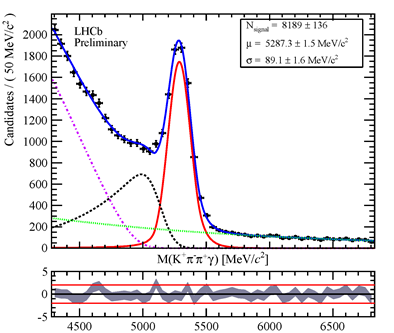The LHCb Collaboration has just presented at the 2013 European Physical Society Conference on High Energy Physics, EPSHEP, Stockholm, Sweden, a first significant non-zero measurement of an observable proportional to the photon polarisation in b→sγ transition. The transition of a b-quark to an s-quark by emission of a photon (γ) is considered a very important process to investigate possible manifestation of new physics. This decay process is forbidden in the first approximation in the Standard Model (SM) of particle physics and moreover in the second-order processes that govern the process in the SM the emitted photon is expected to be strongly polarised. Therefore it is very sensitive to new physics effects arising from the exchange of new heavy particles in electroweak penguin diagrams (see 14 June 2013 news). Indeed, several models of new physics predict that the emitted photon should be less polarised than in the SM. Up to now different experiments have measured the decay rate of this process, ruling out significant deviations of the rate from the SM prediction and strongly reducing the allowed parameter space of new physics models. The photon polarisation was, however, never previously observed.
Free quarks are not observed in nature. Therefore physicists measure the b→sγ transition in decays of particles containing a b quark, like B mesons, into strange particles containing a s quark, like K mesons. The LHCb physicists have used the process B+→Kresγ where excited K meson states, Kres, decay in turn into three particles, K+, π– and π+. The red distribution in the image shows the contribution of more than 8000 signal events reconstructed and selected in the 2012 data sample, corresponding to an integrated luminosity of about 2 fb-1 collected in pp collisions at 8 TeV. The other distributions show different background contributions. An angular analysis of the B+ decay products has allowed to obtain first evidence, with 4.6σ significance, for photon polarization in the b→sγ transition with respect to the no-polarization scenario. Further theoretical analysis is, however, needed to obtain a numerical value for this polarization.
Read more in the LHCb presentation in Stockholm and in the LHCb conference note here.
click the image for higher resolution

